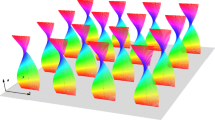Abstract
Two-dimensional scalar fields (e.g. pictures) are often described by way of a linear superposition of simple base functions. It is argued that such decompositions are often unnatural in the sense that the decomposition takes no regard of the structure of the field and it may happen that the parts are more complicated than the whole. Moreover, such decompositions are not invariant with respect to even small topological deformations of the dimensions or the grey scale of the picture, whereas such deformations do not affect the perceptual structure. We present a method to decompose two-dimensional scalar fields in the following way: the whole is a hierarchically structured superposition of parts, such that these parts are featureless (do not contain local extrema or saddle points). The hierarchical structure can be considered a generative grammar for smooth pictures. The concept is extended towards pictures that are sampled with a collection of graded apertures. We introduce the concept of the aperture spectrum, this construct describes the structure of a picture sampled with any aperture. This kind of description is likely to be important for the analysis of visual functions.
Similar content being viewed by others
References
Anstis, S.M.: The naked jigsaw: getting it together. York University, Department of Psychology, Reports. Report No. 52, October 1976
Ballard, D.H., Sklansky, J.: A ladder-structured decision tree for recognizing tumors in chest radiographs. IEEE Trans. Comput. C-25, 503–513 (1976)
Berge, C.: Théorie des graphes et ses applications. Paris: Dunod 1958
Cayley: see Maxwell, J.C.: The scientific papers of James Clerk Maxwell. Vol. II: On Hills and Dales, p. 233. Niven, W.D. (ed.). Cambridge: Cambridge University Press 1890
Eells, J., Jr.: Singularities of smooth maps. New York: Gordon and Breach 1967
Ehrich, R.W., Foith, J.P.: Representation of random waveforms by relational trees. IEEE Trans. Comput C-25, 725–736 (1976)
Enroth-Cugell, C., Shapley, R.M.: Flux, not retinal illumination, is what cat retinal ganglion cells really care about. J. Physiol. 233, 311–326 (1973)
Fischer, B.: Overlap of receptive field centers and representation of the visual field in the cat's optic tract. Vision Res. 13, 2113–2120 (1973)
Graefe, O.: Qualitative Untersuchungen über Kontur und Fläche in der optischen Figurwahrnehmung. Psychol. Forsch. 27, 260–306 (1964)
Harmon, L.D.: The recognition of faces. Sci. Am., November, 71–82 (1973)
Hunter, R.S.: The measurement of appearance. New York: Wiley & Sons 1975
Ikeda, M., Saida, S., Sugiyama, T.: Visual field size necessary for length comparison. Percept. Psychophys. 22, 165–170 (1977)
Koenderink, J.J., Doorn, A.J. van: Visual detection of spatial contrast; influence of location in the visual field, target extent and illuminance level. Biol. Cybernetics 30, 157–167 (1978)
Kronecker,: see Eells, J., Jr. Singularities of smooth maps. New York: Gordon and Breach 1967
Land, E.H., McCann, J.J.: Lightness and retinex theory. J. Opt. Soc. Am. 61, 1–11 (1971)
Marr, D.: Early processing of visual information. Philos. Trans. R. Soc. London, Ser. B 275, 483–519 (1976)
Maxwell, J.C.: Ther scientific papers of James Clerk Maxwell. Vol. II: On Hills and Dales. Niven, W.D. (ed.): Cambridge: Cambridge University Press 1890
Metzger, W.: Gesetze des Sehens (Die Lehre vom Sehen der Formen und Dinge des Raumes und der Bewegung). Frankfur/M.: Kramer 1975
Meyer-Eppler, W.: Grundlagen und Anwendungen der Informationstheorie, 2. Aufl. Kommunikation und Kybernetik in Einzeldarstellunge, Bd. 1. Wolter, H., Keidel, W.D. (Hrsg.). Berlin, Heidelberg, New York: Springer 1969
Minsky, M.L.: Computation: finite and infinite machines. Englewood Cliffs, N.J.: Prentice-Hall, Inc. 1967
Morse, M.: Relations between the critical points of a real function of n independent variables. Trans. Am. Math. Soc. 27, 345–396 (1925)
Riseman, E.M., Arbib, M.A.: Computational techniques in the visual segmentation of static scenes. Comp. Graph. Image Proc. 6, 221–276 (1977)
Schober, H., Rentschler, I.: Das Bild als Schein der Wirklichkeit. Optische Täuschungen in Wissenschaft und Kunst. München: Moos 1972
Vasari, G.: On technique. Being the introduction to the three arts of design, architecture, sculpture and painting, prefixed to the lives of the most excellent painters, sculptors and architects. Brown, G.B. (ed.). New York: Dover Publications Inc. 1960
Wong, R.Y., Hall, E.L.: Sequential hierarchical scene matching. IEEE Trans. Comput. C-27, 359–366 (1978)
Author information
Authors and Affiliations
Rights and permissions
About this article
Cite this article
Koenderink, J.J., van Doorn, A.J. The structure of two-dimensional scalar fields with applications to vision. Biol. Cybernetics 33, 151–158 (1979). https://doi.org/10.1007/BF00337293
Received:
Issue Date:
DOI: https://doi.org/10.1007/BF00337293




